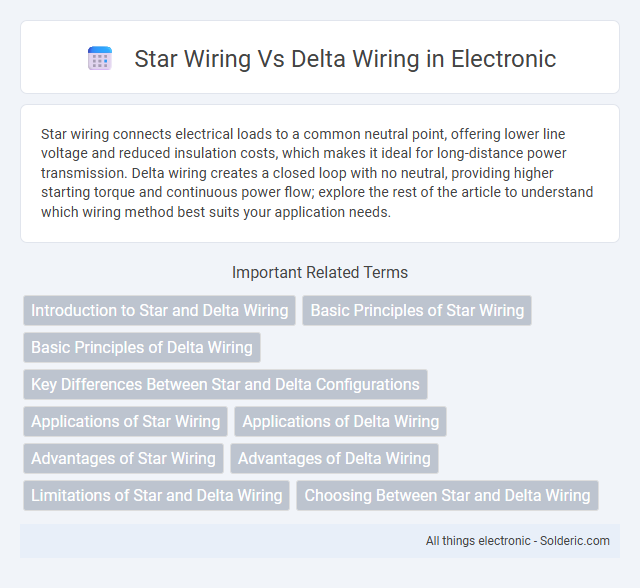Star wiring connects electrical loads to a common neutral point, offering lower line voltage and reduced insulation costs, which makes it ideal for long-distance power transmission. Delta wiring creates a closed loop with no neutral, providing higher starting torque and continuous power flow; explore the rest of the article to understand which wiring method best suits your application needs.
Comparison Table
| Feature | Star Wiring (Y-Connection) | Delta Wiring (D-Connection) |
|---|---|---|
| Configuration | Each phase connected to a common neutral point | Each phase connected end-to-end forming a closed loop |
| Voltage | Phase voltage is line voltage divided by 3 | Phase voltage equals line voltage |
| Current | Line current equals phase current | Line current is 3 times phase current |
| Neutral Availability | Neutral point available for grounding and single-phase loads | No neutral point available |
| Application | Used in long-distance transmission and balanced loads | Used for motors and heavy load equipment |
| Fault Tolerance | Better for unbalanced loads and provides neutral protection | Handles high starting torque loads better |
| Power Calculation | P = 3 x VL x IL x cosph | P = 3 x VL x IL x cosph |
Introduction to Star and Delta Wiring
Star wiring connects each load to a common neutral point, distributing voltage evenly across phases, which enhances system stability and is ideal for long-distance power transmission. Delta wiring forms a closed loop between phases, allowing higher starting torque and continuous power supply even if one phase fails, making it suitable for heavy machinery. Understanding your system's power requirements will help determine whether star or delta wiring best optimizes efficiency and performance.
Basic Principles of Star Wiring
Star wiring connects all the motor windings to a common neutral point, forming a "Y" shape that reduces the voltage applied to each winding to phase voltage rather than line voltage. This configuration minimizes starting current and is frequently used in three-phase motors to enhance safety and reduce electrical stresses. The star connection enables efficient power distribution and allows for simpler motor control in low-voltage applications.
Basic Principles of Delta Wiring
Delta wiring connects three electrical loads in a closed loop, forming a triangle where each load is directly connected between two phases, allowing for a continuous current flow. This configuration provides a higher phase voltage and can support heavy loads, making it ideal for industrial applications. Your choice of delta wiring ensures balanced power distribution and reduces the risk of voltage drops in three-phase systems.
Key Differences Between Star and Delta Configurations
Star wiring connects each load to a common neutral point creating a stable, neutral reference, ideal for balanced voltage and systems requiring neutral grounding. Delta wiring forms a closed loop with each load connected between two phases, delivering higher phase voltage and allowing for more efficient power distribution in three-phase systems without a neutral. Understanding these key differences helps you select the right configuration for your electrical system's voltage, current, and load balancing requirements.
Applications of Star Wiring
Star wiring configuration is commonly used in applications requiring a neutral point, such as in residential power distribution and electric motor startups to reduce initial current surge. It provides balanced voltage across each phase, making it ideal for long-distance power transmission where voltage stability is crucial. Your systems will benefit from the lower insulation requirements and safer handling inherent in star wiring, especially in three-phase power setups.
Applications of Delta Wiring
Delta wiring is commonly used in industrial applications such as heavy machinery and large motors due to its ability to provide high starting torque and carry heavy loads efficiently. It is ideal for systems requiring constant power, including compressors, pumps, and conveyor belts, where three-phase power distribution enhances performance and reliability. The configuration allows motors to run on a lower current, reducing the risk of overheating and improving overall operational stability in demanding environments.
Advantages of Star Wiring
Star wiring offers improved safety by maintaining a neutral point, reducing the risk of electrical shocks during faults. It enables easier voltage regulation and allows the use of dual voltage systems, enhancing flexibility for various applications. The balanced load distribution in star wiring minimizes power losses and improves overall system efficiency in three-phase electrical setups.
Advantages of Delta Wiring
Delta wiring offers advantages such as providing higher starting torque and better suitability for heavy load conditions, making it ideal for industrial motors. It allows continuous operation even if one phase is disconnected, ensuring greater reliability and reducing downtime. Your choice of wiring can optimize motor performance and efficiency in demanding applications.
Limitations of Star and Delta Wiring
Star wiring limits the maximum current through each phase, restricting its use in high-power applications due to lower current capacity. Delta wiring faces issues with phase imbalances that can cause overheating and increased maintenance in three-phase motors. You should consider these limitations when designing electrical systems to ensure safety and efficiency.
Choosing Between Star and Delta Wiring
Choosing between star and delta wiring depends on your electrical system's voltage requirements and load characteristics. Star wiring provides a neutral point, making it ideal for systems needing both single-phase and three-phase power with balanced loads. Delta wiring, on the other hand, supports higher starting torque and is suited for heavy-duty motors where the load is predominantly three-phase without neutral needs.
star wiring vs delta wiring Infographic

 solderic.com
solderic.com